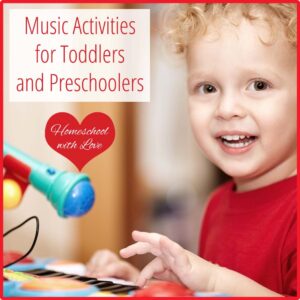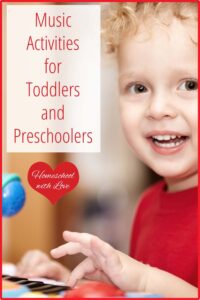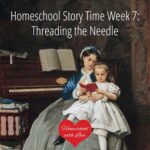
I don’t think that children are ever too young to learn about music.
I exposed my daughters to music in a variety of ways from the time that they were infants. I played recordings of classical music and children’s songs for them. I let them play with age appropriate musical toys. I clapped with them. I tried to do as many fun music activities with them as I could.
The results of this is that now I have two daughters who love to sing and/or play instruments. One has even been a cantor in church.
You too can inspire a love of music in your children from an early age and you don’t have to be musically talented to do so. There are some very simple music activities that you can do with your toddler or preschooler that will introduce him to basic music concepts. I have listed some below. Pick the ones that work well for your family.
Music Activities for Little Hands and Voices
- Listen to and sing favorite children’s songs together.
- Clap along to songs and have your child do so as well.
- Clap a simple rhythm and have your child imitate it.
- Let your child experiment with clapping his own rhythm, then imitate him.
- March along with songs together.
- Let your child play simple instruments such as drums, tambourines, or bells both alone and with a song.
- Play an easy rhythm on an instrument and have your child repeat it.
- Do simple finger plays such as “Pat-a-Cake.”
- Do motion songs such as “The Wheels on the Bus” or “The Hokey Pokey” together.
- Let your child dance to favorite songs. This can be done in front of a mirror.
- Play 30 seconds of a favorite song and see if your child can identify it.
- Sing a few notes with “la” and have your child copy you.
- Introduce your child to a variety of music styles including classical, jazz, and religious music.
- Play music with stories like “Peter and the Wolf” for your child.
- Play a particular song or classical music piece and ask your child how it makes him feel.
- Talk to your child about high and low notes in music. Demonstrate both using your voice or an instrument. Have your child play or sing both types of notes. See if he can identify high and low notes.
- Talk to your child about loud and soft music. Demonstrate by playing or singing music at different volumes, then let him experiment with doing so. Sing or play music for him and see if he can identify loud and soft.
- Talk about tempo with your child. Play or sing a song fast and slow. Have your child join you in doing the same. Then see if he can identify fast and slow tempos of songs you play for him.
- Show pictures of a few common musical instruments. Play solos performed by that instrument. Later, see if your child can identify an instrument by appearance and sound.
- Let your child make simple musical instruments. You can find instructions for a variety of instruments online.
Bookmark or pin this post so you can find it again.









Love # 19!
Thanks! I think it’s a great way for young children to practice auditory discrimination.
Love it! Thank you so much for demonstrating the importance of including music in homeschool! Our favorite way of including music at home is having our child create their own! We have drums and other instruments all over the downstairs. We also write about ideas for incorporating music at home here http://raisingcreativechildren.net
That’s amazing! I love how you have instruments all over your home for your children to play. And thanks for the link!